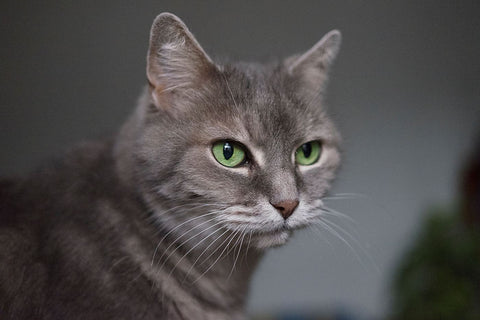
One of the sections of your Basepaws Cat DNA report is the Wild Cat Index. This section of the report reveals a few secrets about your cat's wild and wonderful ancestry and gives you an insight into the evolution of your very own home tiger.
It’s the most fun part of the report (read: genetics plays a small part here) but we include it to highlight just how pawsome felines of all sizes are. Here is what you need to know about feline evolution in order to understand your Basepaws Wild Cat Index.
Feline evolution
Your cat might love a soft couch and fancy canned food, but all it takes is the flutter of a bird or the twinkle of a laser pointer to remind your cat that she is a true born hunter. Cats were first adopted by humans only 10,000 years ago and your cat’s DNA is only a pounce away from its wild ancestors. Every domestic cat has more in common with some wild cousins than others, however, due to evolution and the random chance of inheritance.
All living cats, big and small, shared the same ancestors around 10 million years ago. The progressive evolution of the common ancestor eventually led to the development of 37 modern cat species. According to ancient feline DNA analysis, the most recent wild ancestor of domestic cats in particular seems to be the African wildcat (lat. Felis silvestris lybica) (Ottoni et al, 2017).
As the evolution of cats progressed, some cats inherited more or less DNA from their common ancestors. This is because every cat inherits 50% of their DNA from the mother and 50% from the father. However, which part of the mother's or father's DNA is inherited is completely random, thus allowing each and every kitten to be completely genetically unique.

Figure by Figueiró, H. V., et al. (2017)
Your cat is therefore more related to some species of wild cats than others. The closest relatives of domestic cats are the African and European wild cats, and the Chinese desert cat. This means that your cat shared ancestors with these wild cats much more recently than with their most distant relatives (lions, jaguars, tigers and leopards).
However, even though the feline family tree diverged around 10 million years ago, domestic cats and their long-distanced relative still share a lot of DNA. Domestic cats and tigers, for example, have 95.6% of their DNA in common.

Mixed ancestry of the hybrids
Sometimes, two different species of cats get together and create kittens called "hybrids". Cat breeders often do this on purpose, mating wild cats with house cats to create popular cat breeds like the Bengal or Savannah. This also sometimes occurs in zoos, resulting in cats like leopons, half leopards and half lions, or pumapards, and half pumas.
Cat hybrids can also happen in the wild. Hybrids are usually infertile (cannot have kittens), but if they do reproduce, their offspring will move DNA from one cat species into another species. This complicates how scientists use DNA to trace wild cat ancestry, because ancient hybrid relatives make distant wild cat relatives appear to be closely related. This has happened repeatedly during the evolution of cats.
Does my cat's highest breed is in its wild cat index mean their grandparent may have been one of those wild cat?
Not likely. High-ranking results are more likely to occur due to the hybrids present in the domestic cat population Hybrids occur more often in closely related species of cats, particularly in places where domestic cats are in regular contact with closely related wild cats. For instance, in Germany where the European wildcat lives, close to 20% of the European wildcats have domestic DNA mixed into their recent ancestry.
Therefore, if your cat has a hybrid in his ancestry, then his DNA will be more similar to his wildcat ancestor compared to a typical domestic cat. Please remember that it is not recommended to attempt and create a hybrid on your own.

In Perspective: Humans and Neanderthals
Just like cats, humans have also been influenced by hybrid DNA. We, humans, have anywhere from 0% to 4% Neanderthal DNA, depending on where our ancestors are from. That means that some people are more related to Neanderthals than other people are. But here’s the tricky part: The average human’s DNA is 99.5% similar to Neanderthal DNA. How can both of these statistics agree?
By evolutionary calculations, humans and Neanderthals last shared a common ancestor a few hundred thousand years ago. This is why our DNA is very similar to Neanderthal DNA. However, Neanderthals and early humans had hybrid babies before Neanderthals went extinct around 40,000 years ago. These hybrids integrated into the human population and are ancestors to some of us.
If you have more Neanderthal DNA than everyone else, then around 4% of the sections of your DNA will be 100% similar to Neanderthal DNA instead of only 99.5% similar. You might be "more Neanderthal" than everyone you know, but you are still human, and only a tiny bit "more Neanderthal" than other people. Overall, your DNA will only be 0.02% closer to Neanderthal DNA than a person who does not have a Neanderthal hybrid ancestor.
Likewise, when your house cat has more wildcat DNA than any other house cat, your cat is still genetically a house cat. Unless you adopted a wildcat.
Basepaws Wild Cat Index
Basepaws has developed a unique genetic test that compares your cat’s DNA sequence to different wild cats. Our Wild Cat Index tells you which wildcats your cat is most related to, ranked in comparison to other domestic cats in our database.




